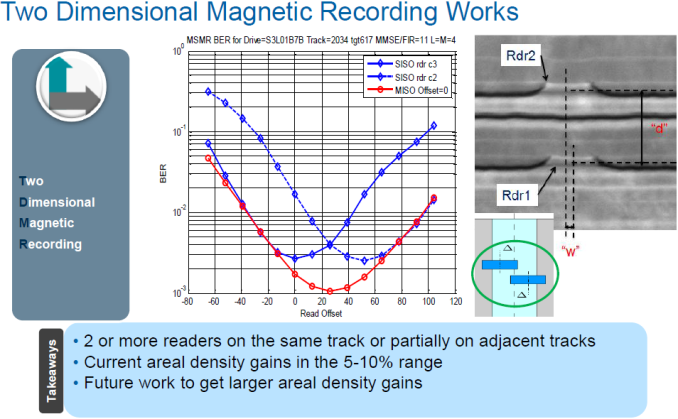The Evolution of HDDs in the Near Future: Speaking with Seagate CTO, Mark Re
by Anton Shilov on July 6, 2016 2:00 PM ESTTwo-Dimensional Magnetic Recording Due in 2017
Two-dimensional magnetic recording (TDMR) is a yet another technology that should help to increase areal density and this is something that Seagate is investing in. The manufacturer believes that TDMR helps to increase areal density by 5% to 10%. Plans were announced several months ago and during the conversation with Mark Re, it was confirmed that Seagate was on track to release its first commercial TDMR-based HDDs in 2017.
TDMR technology enables makers of hard drives to increase the areal density of HDD platters by making tracks narrower and pitches even smaller than they are today. While it is possible to minimize the writer (a part of an HDD's head that writes data), reading becomes a challenge. As magnetic tracks become narrower, they start to affect each other, an effect called magnetic inter-track interference (ITI). This means It becomes increasingly hard for HDD heads (readers) to perform read operations. To mitigate the ITI effect of very narrow tracks, two-dimensional magnetic recording technology uses an array of heads to read data from either one, or several nearby tracks (a method described in several scientific publications). This improves the signal-to-noise ratio delivered to the controller. Several readers enable HDD controllers to determine the correct data based on input from several locations, which implies the need for powerful controllers. More importantly, a number of read heads will be a benefit for HDDs featuring HAMR in the future: heat-assisted recording improves the write process, whereas multiple readers improve the read process. We are also told that with relevant programming, hard drives featuring an array of readers per head can increase the performance of HDDs. This will clearly not make the new hard drives as fast as SSDs, but it will help Seagate’s customers (particularly in the SAS space) to increase the performance of their storage devices. Right now, Seagate does not talk about its plans to use multiple readers in commercial drives because such products are several years out, but considers this a possibility.
Seagate confirmed that TDMR lets HDD makers to increase areal density by up to 10%, which is a noticeable amount compared to typical PMR platters. However, additional capacity does not come free in this case when it comes to computing. An array of heads increases bandwidth requirements for the controller as well as the amount of information that the chip needs to process. As a result, the whole TDMR platform becomes generally expensive: it features multiple arrays of heads, new platters, new motors as well as new controllers. This is why Seagate plans to use it for server applications first sometime in early 2017. Seagate did not confirm whether such HDDs would use both TDMR and helium, but said that virtually all technologies could be mixed and matched to build the right solution for every possible application. Keep in mind that these are plans which are subject to change.











91 Comments
View All Comments
abrowne1993 - Wednesday, July 6, 2016 - link
Is that all for one second of CGI in the new Transformers movie?Michael Bay - Thursday, July 7, 2016 - link
And some porn.Holliday75 - Friday, July 8, 2016 - link
Is Megan Fox back? She could probably use the cash.JlHADJOE - Monday, July 11, 2016 - link
8 Terra bits? So 1TB =)wumpus - Thursday, July 7, 2016 - link
@JoeyJoJo123>It's ogre. HDDs are dead. SSDs won.
>Just give up.
Know how I know your data isn't backed up? There are two types of people. Those who have lost all their data, and those who are going to (possibly again).
Sure, you might not know how Amazon is storing your data, but I'll bet that it just isn't backed up.
Hard drives just moved up the data hierarchy. They are now stuck between tape (near the cost/TB without the huge entry costs) and SSD. They are also still ideal for NAS, especially consumer grade to fairly decent grade. Don't forget all the random access advantages HDDs have over tape.
I also expect to watch the whole HDD/SSD dance play over again with SDD/3dxpoint. Although the more interesting story will be if 3dxpoint will be able to replace main/virtual memory, leaving multi-GB DRAM "caches" between the CPU and "main memory".
Perhaps Mr. Ogre needs to consult with the tri-lambs. I'm sure they could find some uses for HDDs.
Nagorak - Monday, July 11, 2016 - link
I'm having difficulty understanding your comment but if you're implying that data stored on AWS isn't backed up then I find that almost inconceivable.hectorsm - Thursday, July 7, 2016 - link
You're delusional. Today ~99% of PC shipments still have HDDs.romrunning - Wednesday, July 6, 2016 - link
SMR was never a technology that ever interested me. I don't want more storage with measurably worse performance than existing ones. Seagate should have invested more into SSD tech than in SMR for HDDs.JoeyJoJo123 - Wednesday, July 6, 2016 - link
You can do both. SMR for the platters with additional flash cache for frequently accessed data. Unfortunately HDDs are a one trick pony now, and they need to push in the one area they're better than SSDs in (relative amount of storage per $ spent).extide - Thursday, July 7, 2016 - link
Yeah I always thought the combo of a SMR drive + some NAND cache was like super obvious, and I am wondering why we haven't seen more drives like that.